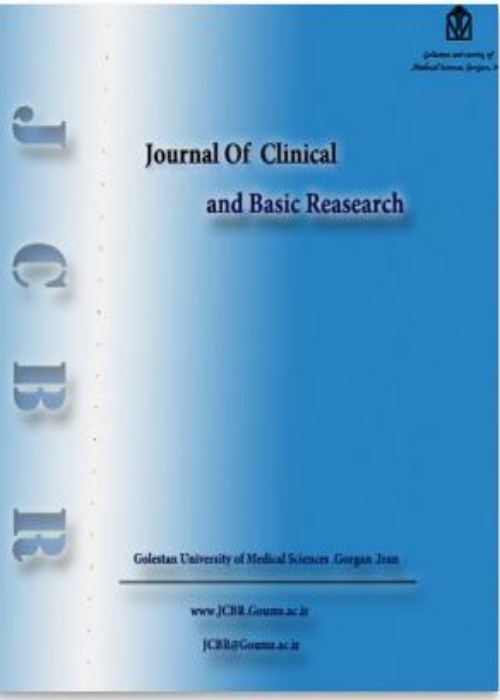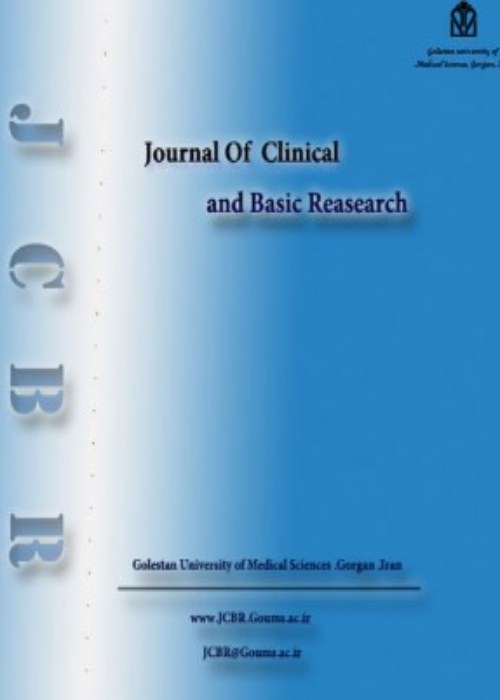فهرست مطالب

Journal of Clinical and Basic Research
Volume:7 Issue: 1, Winter 2023
- تاریخ انتشار: 1402/04/10
- تعداد عناوین: 7
-
Pages 1-5Background
Preoperative anxiety is a widespread phenomenon in anesthesia, a challenging issue for the caring team in evaluating and managing patients’ anxiety. This study aimed to determine the operating room (OR) healthcare providers’ point of view on the patients’ anxiety under regional anesthesia.
MethodsThis cross-sectional study was conducted on 203 OR healthcare providers in the adult public educational hospitals of Golestan University of Medical Sciences, Gorgan, Iran, from April to November 2021. Eligible OR healthcare providers, including nurse anesthetists (104), surgical technologists (82), and anesthesiologists (17), were recruited through the census method. Data were collected using anesthesiologists’ perception of patients’ anxiety under a regional anesthesia questionnaire developed by Jlala (2010). The impact score was determined to ensure the face validity of the Iranian version of the questionnaire, and ten healthcare providers checked it qualitatively. The average score of the content validity index (CVI=0.978) and content validity ratio (CVR=0.978) were acceptable. The instrument’s internal consistency was evaluated using Cronbach’s alpha coefficient (α =0.675). Data were analyzed in SPSS software version 18 using Fisher’s Exact, Chi-Square, and Kruskal-Wallis tests.
ResultsThere were no differences in most questionnaire items between healthcare providers’ views based on their professional roles (P<0.05). More than half of the patients who were candidates for spinal anesthesia were anxious (57.1%). Incorrect information from non-experts, family, friends, and the media often increased patients’ anxiety (59.3%). The most commonly used method for managing patients’ anxiety is sedation using medication (40.9%) and relaxation techniques (35.5%).
ConclusionsHealthcare providers considered that anxiety of patients who were candidates for regional anesthesia was a prevalent problem that can be affected by various factors. All necessary facilities should be considered to create and maintain patients’ comfort in the OR.
Keywords: Anxiety, Anesthesia, Healthcare provider, Operating room -
Pages 6-8Background
Cancer treatment using drugs metabolized by the enzymes dihydropyrimidine dehydrogenase (DPYD) and UDP-glucuronosyltransferase 1A1 (UGT1A1) results in adverse effects for some patients. This is frequently reported in cancer patients undergoing therapy with 5-fluorouracil, capecitabine, and irinotecan who have polymorphisms in the genes coding for DPYD and UGT1A1. The present study assessed the DPYD*2A and UGT1A1*28 polymorphisms in cancer patients before starting chemotherapy to identify the individuals at risk of developing an adverse drug reaction.
MethodsGenomic DNA was isolated from patients and subjected to PCR amplification using specific primers to study DPYD*2A and UGT1A1*28 polymorphisms. The PCR products were assessed by Sanger sequencing for establishing the genotype.
ResultsOf 75 cancer patients requiring treatment with drugs metabolized by DPYD and UGT1A1, 2 (2.66%) and 12 (29.27%) were likely to have adverse reactions based on DPYD*2A and UGT1A1*28 genotyping, respectively.
ConclusionOur findings indicate that carrying out genotyping for these two polymorphisms will help a large number of patients requiring treatment with 5-fluorouracil, irinotecan, and capecitabine.
Keywords: Neoplasms, Chemotherapy, Drug therapy, Pharmacogenetics, 5-Fluorouracil, Irinotecan, Enzyme -
Pages 9-12Background
The present study aims to assess chromosomal instabilities between fertile couples and couples with recurrent pregnancy loss (RPL) and the causative relation of chromosomal instabilities with RPL.
MethodsA case-control study was performed with a study sample of 27 couples with a history of RPL who attended the Department of Obstetrics and Gynecology, Jawaharlal Institute of Postgraduate Medical Education and Research (JIPMER) and twenty-seven healthy fertile couples as controls. The procedure done was Cytokine Blocked Micronucleus Assay (CBMN). After obtaining consent and details of the couple, 3 ml of heparinized blood was collected from cases and controls. Cases comprising couples with RPL (gestational age ≤ 24 weeks) were included, and couples with a history of diabetes mellitus, thyroid disorders, and hypertension were excluded. Among cases, women with a history of two or more two spontaneous abortions ≤ 24 weeks of gestation were selected. Blood was collected and assessed from both male and female partners. The lymphocytes were cultured per the standard protocol and were screened as the number of micronuclei per 1000 binucleate cells under X 200 magnification in CBMN.
ResultsChromosomal instabilities in the form of micronuclei in cases were found to be 7.52±3.99 and 0.07±0.26 in controls (p˂0.05). A statistically significant difference was revealed among those with and without chromosomal instability.
ConclusionChromosomal instability serves as a significant causative factor for those couples leading to pregnancy losses
Keywords: Chromosomal instabilities, Micronucleus assay, Recurrent pregnancy loss -
Pages 13-20
Diabetes and diabetic complications have been a global menace for a long time, putting a heavy burden on an individual, the health sector, and governments. Diabetic complications attributed to persistent hyperglycemia create a challenge in managing diabetes, considering the nature of the disease as a group of metabolic disorders. Various phytochemicals target different metabolic pathways and molecules through different mechanisms of action, acting individually or synergistically to achieve therapeutic goals. Phytochemicals such as alkaloids, saponins, glycosides, terpenoids, and flavonoids were reported to exert different anti-diabetic effects, including anti-hyperglycemic, anti-hyperlipidemic, anti-inflammatory, antioxidant, and insulinotropic activities. The present review focused on the recent advances in the therapeutic potentials of phytochemicals in managing diabetes and diabetic complications, emphasizing their in vitro and in vivo studies.
Keywords: Anti-diabetic, Diabetes mellitus, Medicinal plants, Phytochemicals, Therapeutic roles -
Pages 21-24Background
Psychological stress (PS) disrupts the gut microbiome, accelerates cognitive decline, and causes a predisposition to certain neurodegenerative diseases. This study was designed to test the hypothesis that the administration of probiotics has beneficial effects on the neurohistology and neurochemistry of the hippocampus following exposure to psychological stress (PS).
MethodsThirty-five adult male Wistar rats weighing 180±5g were randomly assigned to seven groups (n=5) comprising the control, acute PS, acute probiotic treatment (probio), acute PS+probio, chronic PS, chronic probio, and chronic PS+probio groups. Acute stress and chronic PS or probio treatment lasted seven and 14 days, respectively. Each animal in the probio groups was fed 10×106 colony-forming units of lactobacillus acidophilus every other day. In contrast, the PS groups were exposed to predator stress for one hour between 7-10 am daily. The treatments lasted for 14 days. Following euthanasia, blood and hippocampal samples were collected for histology, and ELISA-based assays of interleukin-1β (1IL-1β), Tumor Necrosis Factor-α (TNF-α), dopamine, serotonin, malondialdehyde (MDA), catalase (CAT), superoxide dismutase (SOD), and reduced glutathione (GSH).
ResultsData analysis reveals that acute and chronic psychological stress significantly depresses hippocampal serotonin and dopamine levels, induces the overexpression of IL-1β and TNF-α, and causes increased lipid peroxidation and impaired antioxidant parameters. The probiotics groups exhibited statistically better results on all parameters assessed, including bringing hippocampal IL-1β and TNF-α levels toward normal. No obvious histoarchitectural damages were observed in any group.
ConclusionOverall, this study suggests that the gut microbiome might play a significant role in hippocampal function as supplementing it mitigates stress-induced perturbations of hippocampal neurochemistry and redox status.
BackgroundPsychological stress (PS) disrupts the gut microbiome, accelerates cognitive decline, and causes a predisposition to certain neurodegenerative diseases. This study was designed to test the hypothesis that the administration of probiotics has beneficial effects on the neurohistology and neurochemistry of the hippocampus following exposure to psychological stress (PS).
MethodsThirty-five adult male Wistar rats weighing 180±5g were randomly assigned to seven groups (n=5) comprising the control, acute PS, acute probiotic treatment (probio), acute PS+probio, chronic PS, chronic probio, and chronic PS+probio groups. Acute stress and chronic PS or probio treatment lasted seven and 14 days, respectively. Each animal in the probio groups was fed 10×106 colony-forming units of lactobacillus acidophilus every other day. In contrast, the PS groups were exposed to predator stress for one hour between 7-10 am daily. The treatments lasted for 14 days. Following euthanasia, blood and hippocampal samples were collected for histology, and ELISA-based assays of interleukin-1β (1IL-1β), Tumor Necrosis Factor-α (TNF-α), dopamine, serotonin, malondialdehyde (MDA), catalase (CAT), superoxide dismutase (SOD), and reduced glutathione (GSH).
ResultsData analysis reveals that acute and chronic psychological stress significantly depresses hippocampal serotonin and dopamine levels, induces the overexpression of IL-1β and TNF-α, and causes increased lipid peroxidation and impaired antioxidant parameters. The probiotics groups exhibited statistically better results on all parameters assessed, including bringing hippocampal IL-1β and TNF-α levels toward normal. No obvious histoarchitectural damages were observed in any group.
ConclusionOverall, this study suggests that the gut microbiome might play a significant role in hippocampal function as supplementing it mitigates stress-induced perturbations of hippocampal neurochemistry and redox status.
Keywords: Hippocampus, Gut microbiome, Redox status, Neurochemistry, Probiotics, Interleukin, Tumor Necrotic Factor -
Pages 25-29Background
Using magnetic nanoparticles has significant attention in various domains, including magnetic storage, medical therapies, and magnetic detection. Curcumin (diferuloylmethane), a polyphenol, is a low molecular weight active ingredient of the perennial herb Curcuma longa (commonly known as turmeric).
MethodsThe APTES-coated magnetite nanopowders were prepared as carriers for the anticancer drug “Curcumin” through the modified controlled chemical co-precipitation method. The concentration of Curcumin release in the HA-magnetite nanoparticles in 20 ml phosphate buffer (pH 7.4) within the PBS was determined at unique time intervals using UV-Vis Spectrophotometer as finished within the drug loading measurement. The in vitro cytotoxicity of the nanoparticles became assessed through MTT cellular viability assay after treating the MCF-7 breast adenocarcinoma cells with Curcumin-loaded APTES-covered magnetic NPs in addition to unloaded magnetic NPs in line with the manufacturer’s commands.
ResultsThe APTES and HA-coated and uncoated Fe3O4 nanoparticles were characterized by XRD, FE-SEM, FT-IR, Raman, and VSM techniques. The size of the Fe3O4 nanoparticles and their distribution were determined by Hydrodynamic length distribution. TEM results revealed that the average particle size is 15 nm. The VSM measurements showed that magnetic particles were superparamagnetic characteristics. Rapid Curcumin drug loading in 2 hrs and the controlled drug release in 1 hr ~15% and 48 hrs ~80% drug release was observed, applying to in-vitro applications. The obtained findings indicated that the APTES- Fe3O4/HA nanoparticles are promising for targeted Curcumin drug delivery applications.
ConclusionCurcumin-loaded MNPs were more potent than free Curcumin for inhibiting MCF-7 cell proliferation due to enhanced uptake in breast cancer cells. Due to high inherent magnetic properties, we may use the nanomedicine platforms for theranostic application after ensuring the MRI imaging abilities.
Keywords: Fe3O4, Curcumin, Hyaluronic acid, Magnetic nanoparticles, MCF-7, Cancer


